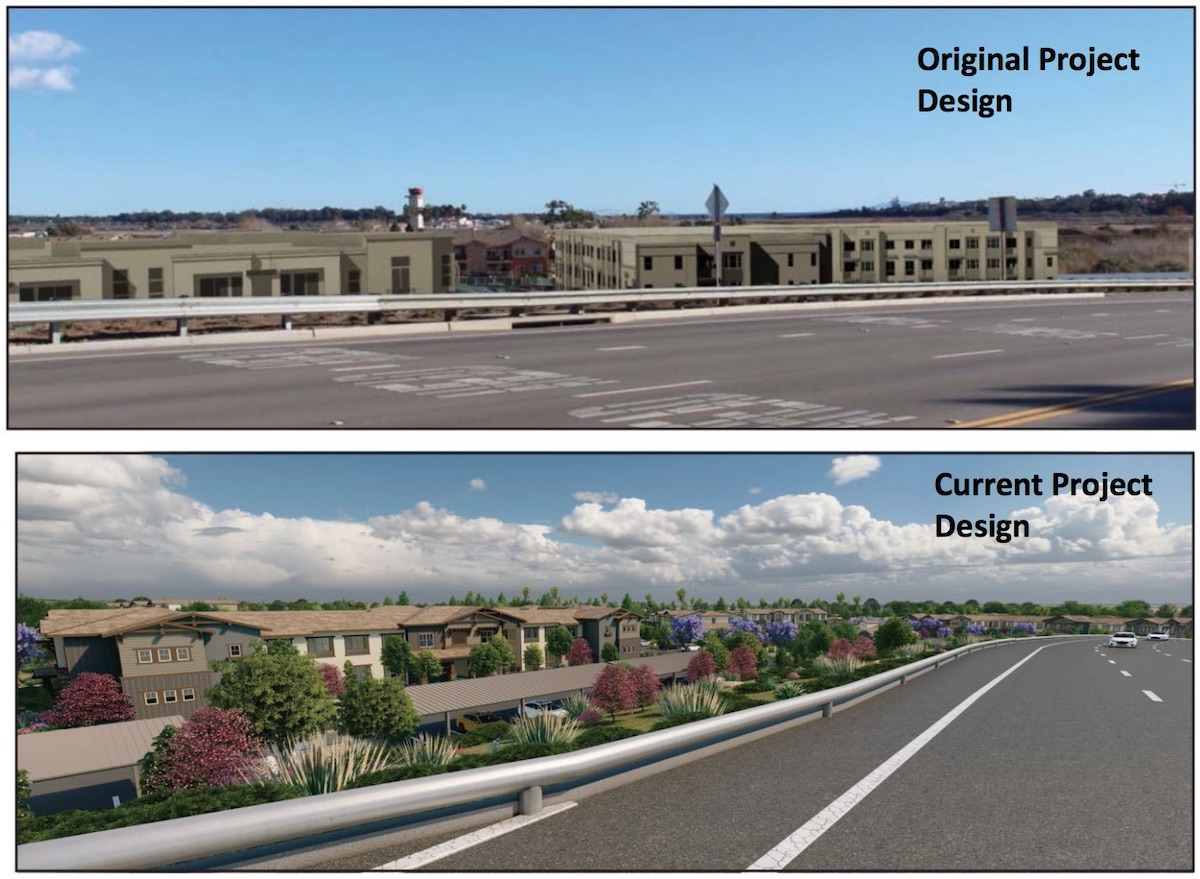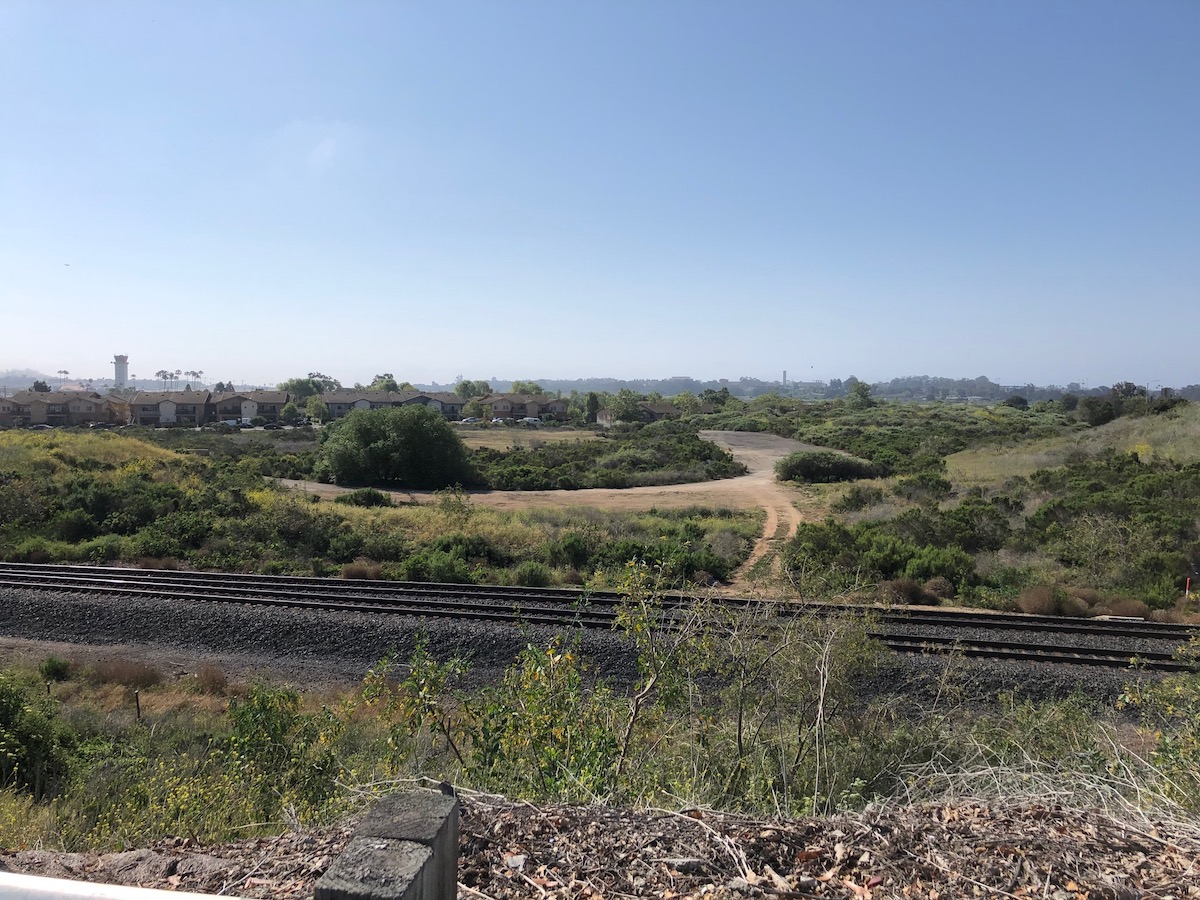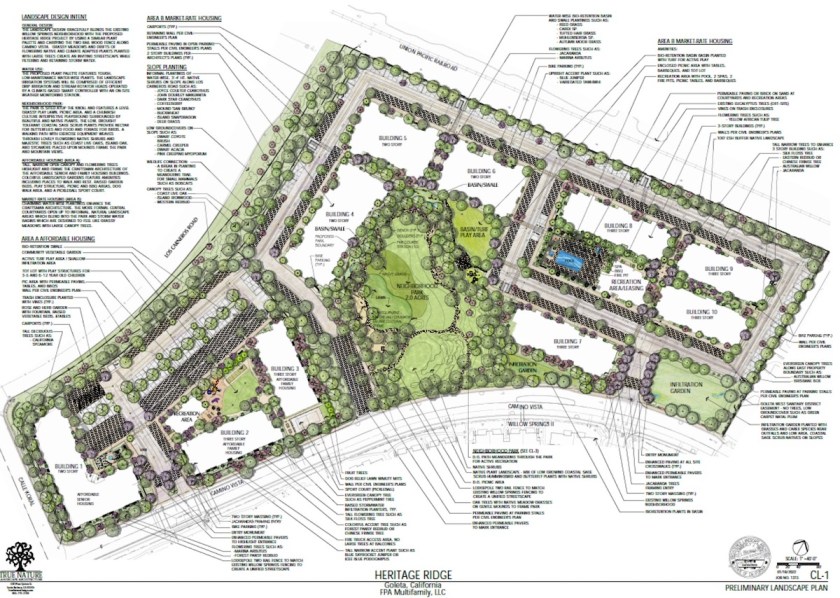Fight Develops over Creek and Habitat at Heritage Ridge in Goleta
Development Proposes 104 Low-Income Homes and 228 at Market Rate

Plans are in the works for 332 new apartments — 104 of them affordable — on one of the last large vacant lots in Goleta, but the property has an unusual problem: water. It’s not the drought or the water entitlement, which the Heritage Ridge development has had since 2002. It’s Los Carneros Creek, which once ran freely across the land, located below the southeast corner of the intersection of Highway 101 and Los Carneros Road. The developers and the Environmental Defense Center are not seeing eye-to-eye over the project’s compliance with the city’s 100-foot creek setback law, an argument that was too complicated for the Planning Commission to decide in a couple hours on Monday evening. The commissioners heard presentations and comments from all the parties, and Chair Jennifer Ferguson continued the hearing to April 25.
Representing the developers, Tim Kihm of TK Consulting said the plans had been through eight revisions, including one that literally moved a building in trying to achieve the 100-foot creek setback Goleta had mandated in 2019. The buildings themselves were modified from rectangular blocks to California craftsman-style buildings, with details offering greater warmth and improved mountain views, he said. The affordable homes ran from studios to three bedrooms, and the market-rate units were one- to three-bedroom apartments. Each grouping contains recreation rooms and outdoor spaces, and one of the market-rate groups has a swimming pool.

The original developer was the Towbes Group several decades ago, which had plans for 360 units of housing. After the death of Michael Towbes in 2017, Redtail Multifamily Land Development bought the land from the Towbes Foundation in March 2020, by which time the project was down to 353 units. In December, Redtail brought the County Housing Authority into the project to take control of the affordable units, for which Redtail would prepare the lots as it worked on the market-rate units on the other half of the property. County Housing Authority is to find funding, build, and manage the low and very low-income homes.
Heritage Ridge is the third of the Towbes’s “Willow Springs” projects; the other two run down to Hollister Road from Camino Vista. The land holds remnants of significant Chumash village sites from pre-history times, more recently covered by orchards. Open space above the cultural sites protects them at Willow Springs I and II. At Heritage Ridge, a two-acre park is planned to protect the scattered site, and members of the Barbareño Chumash participated in the park’s design. The park — which is largely green, open space — sits in the middle of the development’s Camino Vista aspect and will have paths for running and walking peppered with interpretive signs on Chumash history. Children’s play areas and picnic tables fringe the edges of the park, which will be planted in native greenery and trees. Once the project concludes, by its estimated timeline of 2025, the park will be dedicated to the city, which will assume maintenance for the park.
As at the other Willow Springs developments, the groundwater table is close to the surface. The Goleta Slough borders the airport across Hollister Avenue, and water detention basins and wetlands are strategically placed throughout the developments. The other three quadrants of the Highway 101-Los Carneros intersection are mainly occupied by the Village at Los Carneros development — also a Redtail project, with People’s Self-Help Housing building the affordables — Bishop Ranch, and Lake Los Carneros. The creek that descends from the lake creates a riparian corridor interrupted by the Union Pacific railroad tracks before Los Carneros Creek is channeled into concrete banks behind Aero Camino road, an industrial street known for Channel City Hardware at one end and a bus depot and cannabis dispensary at the other.
The elephant in the virtual room on Monday evening was the creek setback, though the Environmental Defense Center also has issues with the city’s contention that the environmentally sensitive habitat once identified on the site no longer exists. The city and the developer had used a map from 2015 to outline the creek setback and the trees that dip their roots down into the creek bed, which EDC said was out of date. The argument is over a difference of six feet.
Sign up for Indy Today to receive fresh news from Independent.com, in your inbox, every morning.
“We really have nowhere else to go,” said Kihm of trying to move the hardscape another six feet. Forty parking spaces had been eliminated and also architectural details on the building facades to get to 100 percent of the setback according to the 2015 map. The developer’s biologist, Mark de la Garza, said the buffer zone was meant to “preserve the streamside protection area in a natural state,” a state that included railroad ties and gravel, he noted.
Attorney Rachel Kondor spoke on behalf of EDC’s five clients — the Santa Barbara Audubon, Sierra Club, and Urban Creeks Council; the Citizens Planning Association; and the Goodland Coalition, a think tank of conservation-minded Goletans — noting that the project is among the first since the city established a 100-foot creek setback for any building along Goleta’s creeks. To allow the project to backdate its mapping had statewide CEQA implications, she said. Chief counsel Linda Krop added that the environmental review had been manipulated to hide information and that it had to be updated to reflect the six-foot encroachment into the creek setback. All agreed the low-income housing was sorely needed, and neither EDC nor its clients were opposed.

Currently, the site contains several tall, brush-covered hills, dotted with yellow flowers after the rains, and also quailbush and coyote brush scrub. About 230,000 cubic yards of soil have been dumped at the site since 2002, coming from Willow Springs II and from projects at UCSB. Grading the site for the project will take a half year of dump trucks coming and going, according to the city staff report. But at issue is whether the plants growing on the site can be categorized as “coastal sage scrub,” as it is identified in older city maps, or whether those plants have been buried by the tons of dirt.
California Fish & Wildlife categorizes coastal sage scrub among the state’s sensitive and therefore protected communities of shrubbery. Further, on this site, the vegetation supports 39 species of birds, the EDC’s Brian Trautwein told the planning commissioners, including the protected white-tailed kite; the monarch butterfly also feeds among the flowers. Many scientific studies identify coyote brush scrub as a type of coastal sage scrub, Trautwein said, indicating its importance by requiring replanting any that is removed at a 2-to-1 ratio.
From among the five organizations that hired EDC, George Relles of the Goodland Coalition pointed to the regular dumping of dirt at the site. “They are responsible for degrading the property,” he said, “and they should not be rewarded by proclaiming the destruction is complete.”
The meeting concluded soon after, and the discussion of Heritage Ridge will resume April 25. By then Goleta’s government meetings will once again be held both in person, with masks recommended, and online.
Correction: People’s Self-Help Housing built the affordable homes at Village at Los Carneros, not the Housing Authority of the County of Santa Barbara.
Support the Santa Barbara Independent through a long-term or a single contribution.




You must be logged in to post a comment.